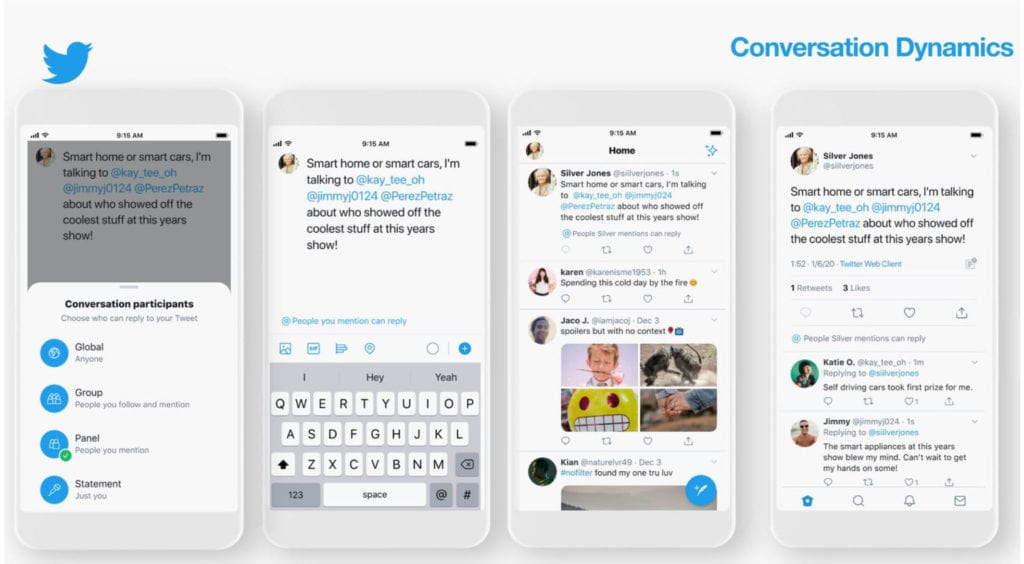

With the start of the year, social media platforms released features that should help communicators with planning for these tools. Twitter’s reply-blocking experiment and Facebook’s war on deepfakes should offer communicators more control over trolls and bots. Less clear is the impact of Facebook’s new feature that allows users to delete data other sites have collected about them. Meanwhile, Instagram released features to assist with organization and reporting.
At CES 2020, Twitter product lead Kayvon Beykpour outlined a change that will allow users to determine who can reply to their tweets. The update is still in the testing phase, but it would be a major shift in the way conversations unfold on Twitter. Users would be able to divide replies into four groups:
- Global: Anybody can reply
- Group: People you follow and mention can reply
- Panel: Those mentioned in the tweet can reply
- Statement: No one can reply
While the change likely will benefit brands beset with large groups of detractors (especially during a crisis), some have voiced concern that the update effectively would censor critics and seed fake news.
“Bad actors spreading misinformation may block fact-checkers from holding them accountable,” said Tom Garruto, director of operations at marketing firm Social Edge.
Ratio No More

Director, Operations
The Social Edge
WIRED coverage of Beykpour’s CES interview noted the update would end the phenomenon of the ratio, where negative sentiment outweighs positive in the replies section.
A ratio signals an unpopular or offensive opinion -- perhaps the only kind of high-volume engagement that brands like to avoid. It is feasible, though, that without ratios, brands would be slower to recognize messages that miss the mark. This amounts to a loss for Twitter’s social listening and monitoring capabilities.
With corporate-reputation building and protection being a central part of the PR pro’s remit, communicators may need to institute workarounds so they can adequately monitor the social conversation on Twitter.
In addition, brands will need to be selective with their newfound power to silence critics, or risk being deaf to their own mistakes. It’s almost an “Emperor’s New Clothes” conundrum.
Troll-Free Tweeting?

Director,
Social Media
Finn Partners
Some communicators welcomed the change, of course.
“When my colleagues and I heard about the upcoming ability to hide replies, we started dancing through the hallways,” said Justin Buchbinder, director of social media at Finn Partners. “The troll-clogged Twitterverse is a nightmare. All it takes are a few bots or unhinged basement-dwellers to take a conversation in a chaotic direction.”
Twitter Catching up
Buchbinder added that Instagram and Facebook have long since rolled out responses to control audience response -- this is simply Twitter playing catch-up.
Another plus: With more control over replies, communicators would have a new format for conversation among thought leaders and brand accounts. “I’m already thinking about how we might be able to use the panel option for unique conversations, like banter between podcast hosts and guests to promote upcoming episodes,” The Social Edge’s Garruto said. “The interview format really jumps out at me.
This platform’s new features (below) should prove useful to communicators, whether they’re seeking a tamer inbox for direct messages, information on which posts garner the most followers or the ability to gate content by demographic.

Growth Insights: Communicators will be able to track follower growth by post and story. Business accounts can view follower growth over time, by day or by week. This is a Godsend for attributing spikes in follower counts to effective messaging or creative. Buchbinder of Finn Partners noted that the additional growth metrics will be particularly helpful, given the difficulty of increasing Instagram follower counts.
Secondary Inbox: Previously, business accounts received all DMs in the same inbox, translating into an organizational nightmare for some. With the update, inboxes are separated into two tabs: Primary (for messages you’d like to see first) and General.
Age Gating:While Instagram announced it would be hiding content about weight loss from the pages of underage users in 2019, the platform is not offering age-gating controls.
This feature should act as a failsafe for brands advertising regulated products, while ensuring ad dollars are not wasted on viewers outside a target age demographic.
Instagram’s handing over the keys, however, could come at a cost: If a brand is under fire from regulators for age-inappropriate content, it can no longer shift blame to the platform for such an oversight.

VP, Global Policy Management
As fake news continues to plague online discourse, Facebook says it has taken a step to deter the spread of doctored content. In a blog post, Monika Bickert, Facebook’s VP of global policy management, outlined the company’s plans to fight manipulated visuals.
For several years, communicators have feared the damage done to brands and public figures they represent via the propagation of deepfakes. These are videos and photos that use machine learning technology to replace faces and objects with false, but realistic, images.
Facebook’s third-party fact-checkers will remove deepfakes that violate community standards, Bickert wrote.
Those that remain will be demoted in the Newsfeed and are prohibited from running as ads.
Luckily, content that fact-checkers flag will carry warnings alerting users. This plays into Facebook’s new education effort to help users, particularly news organizations, avoid further spread of false visuals. The thinking seems to be that if users are exposed to deepfakes, they can inoculate themselves against future deception.
Communicators can take a free detection course at: https://reut.rs/2RYDGbd
A Plug for Transparency and Control

SVP, Digital
Hunter
As we went to press, Facebook, in a post from chief Mark Zuckerberg, announced a feature that will allow users to see data other sites have gathered about them.
Supplied to Facebook, the data is derived from users’ interactions with sites, such as opening an app, searching on an app, making a purchase, adding an item to a shopping cart or using Facebook to log into an app.
Facebook says it uses the data to target “more relevant” ads to users and suggest groups and businesses to them. For example, after you’ve surfed a site for shoes, Facebook receives that information and sends you shoe ads.
Most important, the new tool, called Off-Facebook Activity, allows users to clear data other sites have collected about them, Zuckerberg wrote in a post on Jan. 28, which Data Privacy Day. The move is part of Facebook’s attempt to quell outrage over the Cambridge Analytica data scandal.
“One of our main goals for the next decade is to build much stronger privacy protections for everyone on Facebook,” Zuckerberg wrote. “We know we have a lot of work to do here, which is why this is such a priority for our teams, and for me personally.” The tool took time to develop, “because we had to rebuild some of our systems to make this possible.”
Zuckerberg believes the tool’s debut “marks a new level of transparency and control.” In addition, Zuckerberg wrote that Facebook, during the coming weeks, will show nearly 2 billion users a prompt “encouraging them to review their privacy settings.”
A Good First Step
Facebook has a history of making grand-sounding announcements that turn out to be not quite as advertised. This one, though, seems largely legitimate. It’s a good first step, said the Electronic Frontier Foundation (EFF), which encouraged other players in the space to follow Facebook’s lead. That said, it’s far from complete transparency.
It “doesn’t come close” to covering all the ways Facebook collects and monetizes data, EFF said. In addition, a survey showed 75 percent of U.S. adults don’t know how to address ad preferences on Facebook. The tool, while useful, puts the onus on users to act. Most won’t.
For Michael Lamp, SVP, digital, at Hunter, Off-Facebook Activity is “definitely a major development,” though he wants to see how it plays out in execution. It also presents a challenge for brands that “rely on Pixel targeting to remarket to consumers on Facebook.”
He notes, however, that consumers who use the tool frequently “are likely averse to advertising in the first place.”
In addition, other social platforms that retarget ads may take advantage of this opportunity, notably Pinterest, “based on its reputation for driving clicks.”
Yet this “only increases the value of truly earned brand coverage on Facebook,” he says. PR pros, Lamp believes, “should remember the micro-lead opportunity of pitching for coverage on Facebook when conducting media outreach.”
CONTACT: [email protected]
